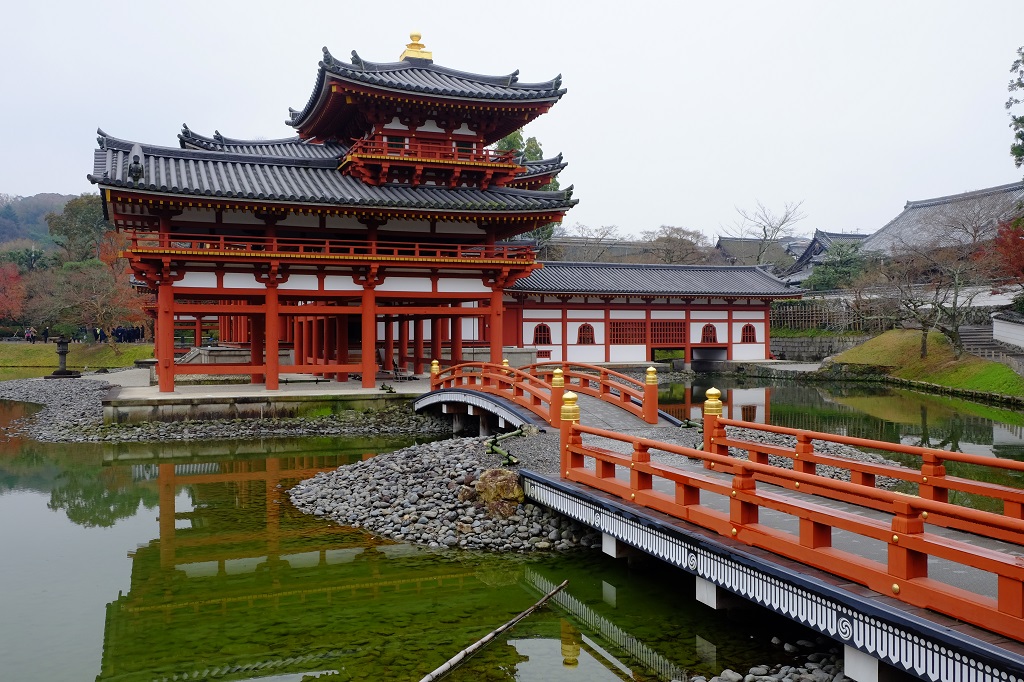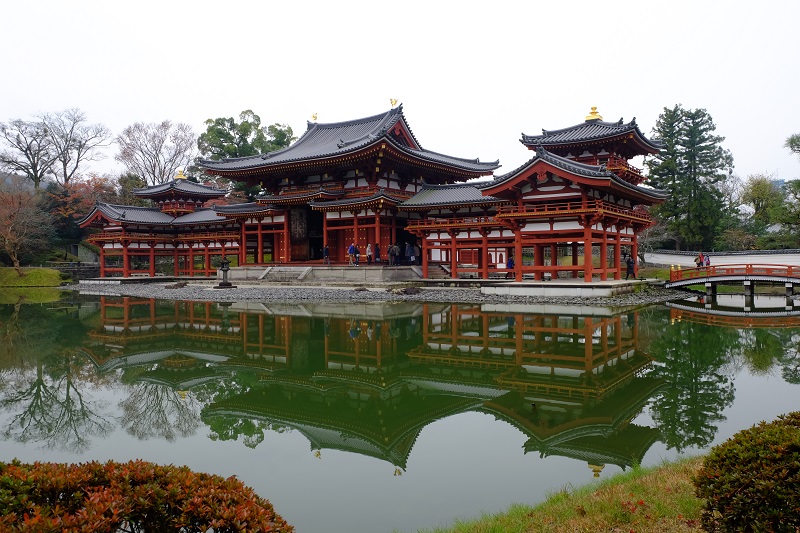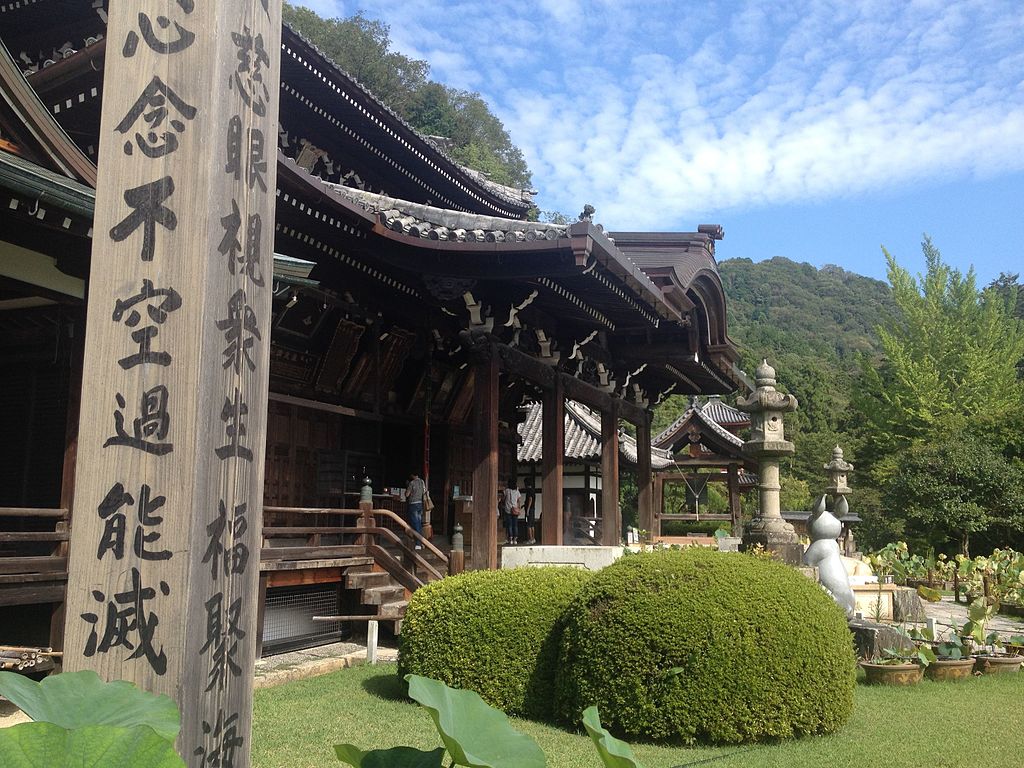Uji
Located in Kyoto Prefecture, Uji is a historical city with a strong connection to the Japanese tea tradition. The city is famous for its green tea, which is grown in its hilly terrain and used in many restaurants and bars in the area. Uji is also home to two UNESCO World Heritage Sites: the Byodoin temple, famous for its architecture and beautiful gardens, and the Uji rice paddy irrigation system, which has been used for centuries by local tea farmers. Uji is an important cultural landmark in Japanese history.

Photo by Japanforeveryone.com
How to get to Uji
From Kyoto Station take the JR train on the Nara Line and get off at Uji (18 minutes by express train, 27 by local train – 240 Yen).
From Nara Station take the JR train on the Nara Line and get off at Uji (32 minutes by express train, 42 by local train – 510 Yen).
Byodoin Temple
The Byodoin Temple is an architectural gem located in the city of Uji, near Kyoto, Japan. Built in the year 998, the temple is famous for its iconic Amida Buddha Hall, which is depicted on the 10 Yen coin. The interior of the temple is fascinating, with beautiful Buddha wood carvings and paintings telling Buddhist stories. Visitors can also admire the beautiful surrounding garden, featuring a pond and lotus flowers. The Byodoin Temple is an emblematic attraction in Uji, representing the spiritual and historical richness of the region.

Photo by Japanforeveryone.com
Practical information
| View location on Google Maps | |
| Official website |
|
| 8:30-17:30 9:00-17:00 (museum) Last admission 15 minutes before closing time 9:30-16:10 (tour of Phoenix Hall – admission every 20 minutes, maximum 20 people per shift) |
|
| No closing days | |
| 700 Yen (garden and museum) Additional 300 Yen for Phoenix Hall |
|
| 10 minutes’ walk east of JR Uji Station 6 minutes’ walk south of Keihan Uji Station |
Mampukuji Temple
The Mampukuji Temple is an ancient and renowned Rinzai Zen temple located in the city of Uji, Kyoto Prefecture, Japan. Founded in 1661, the temple is known for its majestic architecture and serene atmosphere. Inside its halls are beautiful Buddhist paintings and sculptures, while its landscaped gardens offer an oasis of peace and tranquillity. The Mampukuji Temple is a place of Zen practice and meditation, where visitors can immerse themselves in spirituality and find a sense of inner calm. It is an essential stop for lovers of Japanese culture and tradition.
No machine-readable author provided. Fg2 assumed (based on copyright claims)., Public domain, via Wikimedia Commons
Practical information
| View location on Google Maps | |
| Official website |
|
| 9:00-17:00 Last entry 30 minutes before closing time |
|
| No closing days | |
| 500 Yen | |
| 5 minutes’ walk east of JR Obaku station on the Nara line 5 minutes’ walk east of Keihan Obaku station on the Uji line (If using the Keihan line, you must change trains at Chushojima) |
Mimurotoji Temple
The Mimurotoji Temple is an enchanting Buddhist temple located in the city of Uji, Kyoto Province, Japan. Founded in 770, the temple is famous for its magnificent collection of plants and flowers, which include more than 20,000 irises and azaleas. In addition to the garden, visitors can admire the architecture of the temple itself, which features paintings and sculptures of great artistic value. The Mimurotoji Temple is a popular place for nature lovers and photography enthusiasts, as well as for those seeking a break in a serene and spiritual atmosphere.
Daniel M. Dobkin, CC BY-SA 4.0, via Wikimedia Commons
Practical information
| View location on Google Maps | |
| Official website |
|
| 8:30-16:30 (until 16:00 from November to March) Last admission 30 minutes before closing |
|
| 29 to 31 December | |
| 500 Yen | |
| 30 minutes’ walk north-east of JR Uji station on the Nara line 20 minutes’ walk east of Keihan Mimurodo station on the Uji line 25-minute walk northeast of Keihan Uji Station on the Uji line (If using the Keihan line, you must change trains at Chushojima) |
Ujigami Shrine
Ujigami Shrine is an ancient and sacred Shinto shrine located in the city of Uji, Kyoto Prefecture, Japan. Built in the 9th century, it is considered one of the oldest shrines in the country and is admired for its traditional architecture. The shrine is surrounded by a lovely cedar forest and offers a panoramic view of the city and the Uji River.
It is revered as a place of protection and blessing for the local community. Visitors can enjoy a unique spiritual experience by immersing themselves in the mystical atmosphere of this ancient Shinto shrine.
663highland, CC BY-SA 3.0, via Wikimedia Commons
Practical information
| View location on Google Maps | |
| Official website |
|
| 9:00-16:00 | |
| No closing days | |
| Free | |
| 15 minutes’ walk east of JR Uji station on the Nara line 10-minute walk south-east of Keihan Uji station on the Uji line (If using the Keihan line, change trains at Chushojima) |
Koshoji Temple is a charming and peaceful Buddhist temple located in the city of Uji, Kyoto Prefecture, Japan. Founded in 1292, the temple is renowned for its collection of important national treasures.
Inside its halls one can admire ancient Buddha statues and exquisite frescoes telling Buddhist stories. The temple is also famous for its spacious Zen gardens, which provide an ideal environment for meditation and relaxation. Koshoji Temple is a place of peace and reflection, where visitors can immerse themselves in spirituality and artistic beauty.
663highland, CC BY-SA 3.0, via Wikimedia Commons
Practical information
| View location on Google Maps | |
| Official website |
|
| 9:00-17:00 Last entry 30 minutes before closing time |
|
| No closing days | |
| Free | |
| 20 minutes’ walk east of JR Uji station on the Nara line 15-minute walk south-east of Keihan Uji station on the Uji line (If using the Keihan line, change trains at Chushojima) |
The Nintendo Museum is an ambitious project to celebrate the rich history and influence of one of the world’s most iconic video game companies. Nintendo, founded in 1889, went from producing traditional Japanese playing cards (hanafuda) to developing games and consoles that revolutionised global entertainment.
Located on the site of the former Uji Ogura factory, formerly used for the production and support of Nintendo’s home consoles, the museum offers visitors an immersive experience that will take them through more than a century of innovation. The aim is to show the evolution of the brand and the impact its games and devices have had on popular culture.
The museum features a wide range of exhibits, including historical pieces from its early years, iconic consoles such as the NES and Game Boy, and a selection of games that have marked generations of gamers, including ‘Super Mario’, ‘The Legend of Zelda’ and ‘Pokémon’. In addition to the historical exhibits, the museum includes interactive areas where visitors can explore some of the best-loved titles first-hand.
The creation of this space reflects Nintendo’s intention to honour its past while keeping alive the spirit of innovation and entertainment that has made the brand famous worldwide.
IMPORTANT: Tickets for the museum cannot be purchased on site, but only in advance via the Official website. At the moment, they are distributed by a lottery system for a specific date and time slot, with registration open in the three months prior to the visit. For example, for January tickets one can register in October, and the results are announced on 1 November. Each person can only make one application per month, and there are strict rules against reselling tickets.
Nagomijirap, CC BY-SA 4.0, via Wikimedia Commons
Practical information
| View location on Google Maps | |
| Official website |
|
| 10:00-18:00 | |
| Tuesday (Wednesday if Tuesday is a public holiday) 30 December to 3 January |
|
| 3300 Yen (adults) 2200 Yen (11-17 years) 1100 Yen (6-11 years old) |
|
| 25 minutes’ walk west of JR Uji station on the Nara line 7 minutes’ walk east of Ogura station on the Kintetsu-Kyoto line |






